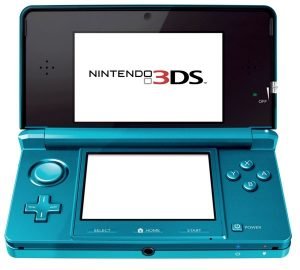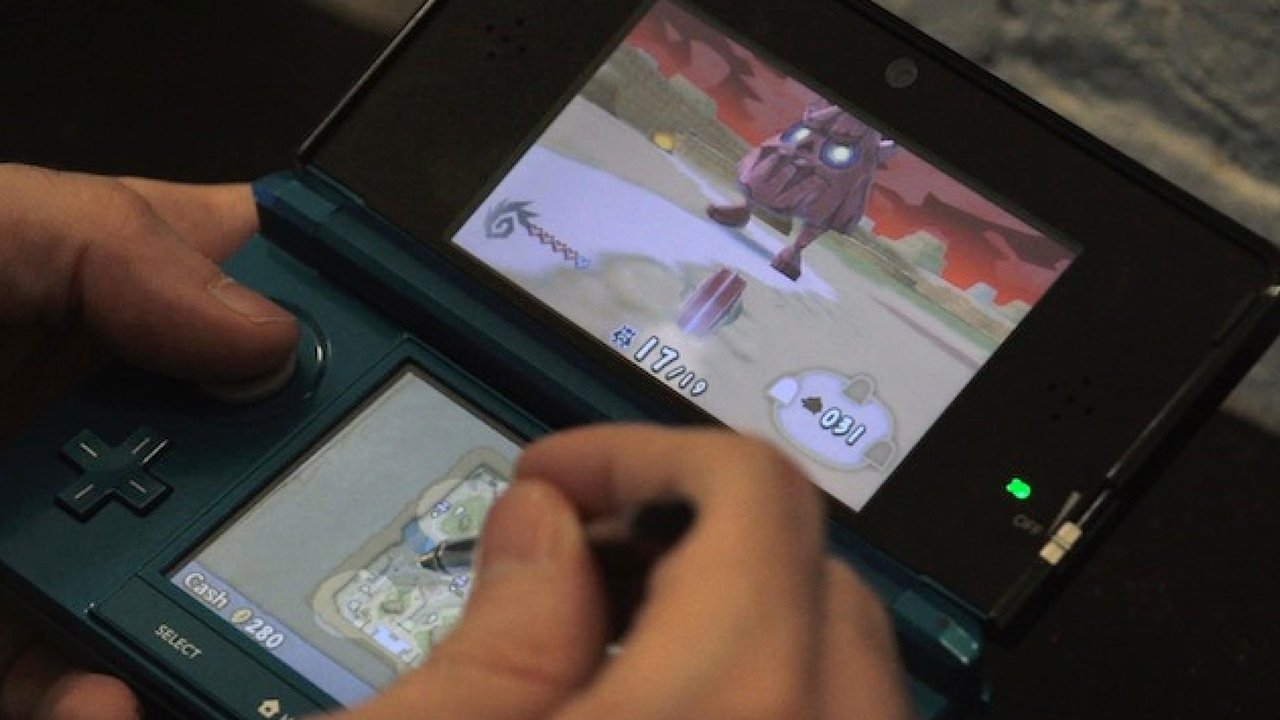The Nintendo 3DS works. That’s the one thing everyone wonders about, it’s the one thing Nintendo has every right to be confident about, but it’s also the one thing no one is going to quite be able to get their head around without actually experiencing it themselves. We got a chance to spend some quality time with Nintendo’s upcoming peripheral when the Big N themselves invited us to a preview in downtown Toronto, and they promised that we’d be able to hold the thing in our own hands and play with it to our hearts content. Happily, this was a promise that they delivered on.
The Hardware
The 3DS bears a lot of similarities to other members of its family, particularly the DSi with which the new unit bears a strong visual design resemblance. It also weighs about the same, perhaps a touch heavier, although it was hard to gauge the exact weight at the showing because of the heavy weights and tethers cabling the units to the floor of the room. The layout of its interface is pretty much the same as past DS iterations, with the exception of the new analog disc set in the upper left side of the bottom panel. Similar in functionality to the “analog nub” of the PSP, it manages to offer another layer of control for more hardcore games, but still doesn’t quite nail the precision of a true analog stick. The stylus for use with the lower touch screen also makes a return, although now its telescopic, neatly collapsing into a smaller form to slot directly into a receptacle built into the top of the 3DS.

Other new additions are the inclusion of two cameras, one mounted on the front of the unit so users can take pictures of themselves, and, more importantly, a dual lens system on the rear for the taking of 3D photos. There’s also been accelerometers and gyroscopes built into the unit so that the 3DS is now aware of its position in space, a feature demonstrated with augmented reality games that we’ll get into later. A charge cradle will also be included with the unit that will plug directly into walls, allowing the 3DS itself to dock with the cradle for recharging purposes. A 2GB memory card will be initially shipped with the unit for storage purposes, though there’s potential for upgrading in the future to higher capacities if that’s not enough.
The 3D Effect
The important thing to understand about the three dimensional effect of the hardware is that it’s not so much you have the sensation of things coming out of the screen at you, so much as you are now able to peer into the screen. It’s like the difference between looking into an aquarium and sticking a sculpture of a hand onto its surface. The 3DS utilizes two individual displays that render an image at slightly different angles to create an illusion of depth that makes the upper screen appear to be a “box” that you almost might be able to reach into in order to interact with the objects that appear there.

This was amply demonstrated with a quick try out of the 3D camera, an effect best displayed with deliberate poses to take advantage of the capability. A picture was quickly snapped with a subject pointing at the camera. A few seconds later the image was processed and the end result was a picture with a very real sense of depth, as if the subject was pointing at—and touching—the screen of the display, as if he were standing on the other side of a glass wall and making contact with it. This 3D effect can also be adjusted to suit preference, thanks to a slider built into the upper right of the unit, with the bottom setting being the complete elimination of 3D for a traditional 2D image gradually sliding up to more discrete levels of depth.
Like 3D movies in the theaters, this effect isn’t perfect. Depth is visibly apparent, but the 3D imaging—or perhaps just the way our brains process the objects—still have trouble with contours. So while the eye notices distinct levels that are closer or further away from the viewer, those levels still seem somewhat flat. In other words, rather than the appearance that a banana is closer to the viewer than an apple, there’s a sense that a cardboard cut-out of a banana is closer to the camera than a cardboard cutout of an apple. The “volume” or actual substance of an object is still problematic, but the sense of distance to the camera is quite clear.
Augmented Reality
With all the shiny new technology that Nintendo has stuffed under the hood, we were curious to see how these would be applied. There were a few demonstrations with “augmented reality” games that utilize a combination of the camera and the motion sensors. A target shooting game was conducted in which a card was placed on a surface which was read by the 3DS. When scanned, targets would appear that were anchored by the card, and players could physically move in their own space in order to get a good angle on shooting at the targets, culminating in a boss fight with a dragon that encouraged players to circle strafe around it in order to shoot is vulnerable areas. Another game, called “Face Raider” involved the player taking pictures of themselves and having those scanned images turned into the face that would be plastered on the space invader like enemies that would fly towards the screen. Players were required to not just move the 3DS vertically or horizontally to get a good firing angle, they also had to rotate themselves whenever an indicator on the HUD warned them of enemies coming in from the side or the rear.

Anyone who’s played games like Eye of Judgment on the PS3, or even the 360/Kinect’s Kinectimals will have some familiarity with this combination of camera and movement based gameplay. The novelty of its use with the 3DS is that since the hardware itself is handheld, this provides an extraordinary amount of mobility and freedom to the players since they are no longer confined to the fixed playfield of a camera’s viewing zone. There’s an obvious potential here for original games, particularly in the multi-player sphere, at this juncture there’s no indications of how far Nintendo or their 3rd party partners are going to take this technology.
The Games
Nintendo had a broad array of games available for sampling, including a lot of new iterations on the classics, such as Legend of Zelda and the largely absent-over-the-console-generations Kid Icarus. Some DS specific titles such as Nintendogs also made an appearance (now with cats) and 3rd party publishers such as Capcom and EA also threw in their hat with a Madden, Resident Evil and Street Fighter game.

As to be expected from a showcase of 3D games on more traditional set-ups such as the PS3 and 3D-TVs, there are some games that seem to benefit more tangibly from the added sense of depth, and others that don’t. Capcom’s Super Streetfigher IV 3D Edition for example, doesn’t have much value added to it as a result of being able to see deeper into the playfield, and using the new over the shoulder view for a greater 3D effect will likely be ignored by more serious players in favor of the traditional 2.5D layout where it’s much easier to gauge the distance to the opponents for attacks. This was something that was also evident in Capcom’s other entry, Resident Evil: The Mercenaries 3D, where playing the game in 3D did little to enhance the existing gameplay, particularly since the game is so fast paced that players often have little time to truly appreciate depth effects, a similar downside to other games like Killzone 3.
On the other hand, Pilotwings Resort seems much more suited to enjoying the sense of depth as players take to the skies in a plane or other vehicles to see mountains, islands and other landscape features move past in a more immersive experience. Even Nintendogs + Cats benefits from the added immersive qualities of greater depth as the more leisurely game of interacting with a virtual pet feels more engaging in 3D. Fans of the mostly missing Kid Icarus will be surprised to hear that the latest game is largely a shooter in the vein of Space Harrier or Panzer Dragoon, with enemies flying towards the screen and once again, the 3D effect is impressive with such a straightforward, “classical 3D” concept.

Unsurprisingly, what almost every game benefits from more than the 3D technology is simply the impressive processing power of the 3DS itself. The jump from a DS or DSi to a 3DS is on the same order of magnitude as switching from the Playstation to the Playstation 2. It’s mind boggling that a hand-held system manages to pump out graphics on Resident Evil: The Mercenaries 3D that are comparable to the original 360/PS3 console versions, but—perhaps in part because of the smaller screen which doesn’t require HD visuals—that’s exactly what’s happening here. Even Super Streetfighter IV manages to put in a very impressive portable outing, and fans of The Legend of Zelda: Ocarina of Time, will be very pleased with the lush, graphical remake the game is getting for its 3DS outing.
In the end, the 3DS is sporting some impressive technology, with a noticeable jump in visual fidelity, even without the feature of “glasses-less 3D.” It still remains to be seen whether the casual audiences will find the novelty of the technology to be worth the $250 price tag, or whether the new trend in gaming from smart phones and iPads has put a permanent spanner in the works for dedicated portable gaming systems such as the 3DS or even Sony’s upcoming NGP. What is clear though is the big thing, the selling point of the 3DS is absolutely on the money. It’s 3D without glasses and it works. How well it will work for games in the long run is another matter entirely, but it DOES work, and it works well.




